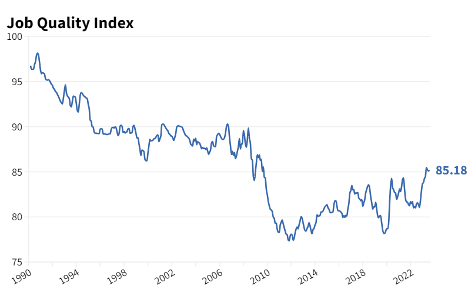WASHINGTON — The Coalition for a Prosperous America (CPA) today announced that the U.S. Private Sector Job Quality Index (JQI) for August was 85.09, up 0.09% from July. After a few months of slowing job growth and a slight decrease in the JQI, the most recent month shows strong job growth in the economy and among goods-producing sectors.
The increase in the JQI for August was mostly driven by sectors increasing pay and hours above the average for existing jobs. Wholesale Trade and Transportation, Warehousing, and Utilities added high-paying jobs in the month. Construction continues to have strong employment growth and created 23,800 additional high-quality jobs in August. Health care and social assistance added 83,100 jobs. About one-third (30,170) were high-quality jobs but most of the job growth in this sector continues to be low quality. Other sectors adding a significant number of low-quality jobs were Accommodation and Food Services (36,000 low-quality jobs) and Arts, Entertainment, and Recreation (19,900 low-quality jobs). Employment growth remains strong throughout the economy and existing jobs are seeing modest wage increases which drove the index up in August.
The average weekly wage for production and nonsupervisory workers in August was $981.56, an increase of 0.32% from July and up 4.06% over the past year. Wage growth remains strong, but after a few months of strong purchasing power gains, workers once again find stubborn inflation of consumer prices, up 0.6% in the past month and 3.7% annually, almost eliminating real wage gains.
Manufacturing Employment Hits 15-Year High
The Bureau of Labor Statistics (BLS) reported overall job gains of 336,000 in September and an unchanged unemployment rate of 3.8%. Overall job growth was much stronger than anticipated. Manufacturing employment increased by 17,000 jobs in September to bring total manufacturing jobs in the economy just above the 13 million mark for the first time since November 2008. The manufacturing investment boom is starting to result in stronger manufacturing job creation, but there is still much to be done to regrow the manufacturing employment base.
The Job Quality Index measures job quality for U.S. production and non-supervisory workers by comparing workers’ weekly wages to the mean weekly wage for all non-supervisory workers. Those jobs above the mean are classified as high-quality and those below the mean are low-quality. The index is calculated by dividing the number of high-quality jobs by low-quality jobs. An index of 100 means the number of high-quality production and nonsupervisory jobs is equal to the number of low-quality jobs. An index below 100 means that the economy includes more low-quality than high-quality jobs.
Over the past three decades, the JQI declined because the U.S. economy created more low-quality jobs than it has high-quality jobs. As shown in Figure 1, the JQI is down 12.0% from 1990 illustrating the disproportionate growth in low-wage, low-hour jobs.
Figure 1. Job Quality Index 1990-2023














